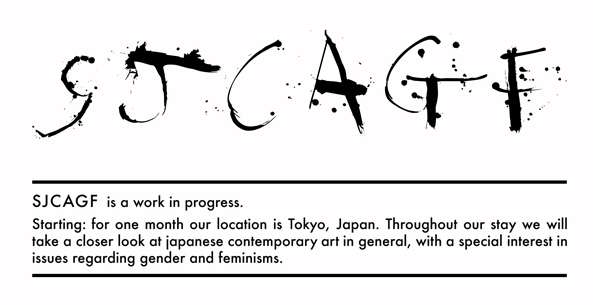Born Yokohama and was brought up during the recession in Japan. BA. in cultural anthropology. Shimada is interested in art from a sociological perspective, working around questions for how art could work in our daily life. Studied at the International Curators program in Stockholm.
SJCAJF met Shimada at a café in Shinagawa-ku and talked about her work and also her thoughts about feminisms in Japan. Here is an extract from her responses regarding feminisms.
“We have a difference between male and female, men and women in the society. And its true that we sometimes feel frustrated about it but it doesn’t create much energy to work around feminism in Japan. The way people react to their frustration is different than from how you deal with it in Europe. Especially younger people or people in my age - maybe in general- first try to accept something before making a change. It sometimes makes things more clear but also sometimes worse. It’s partly because of that that I suspect feminism is not that influential in Japan. We had women leading feminist movements during the 1960s- and 1970s and we achieved a certain amount of change.
I cannot see much feminism in contemporary Japanese art. It’s easier to find that kind of art in the 1960s, 1970s and 1980s. But a few examples could be mentioned. A few years ago the Japanese pavilion at Venice biennale was presenting photographer Ishiuchi Miyako and her works Mother’s. Another example from a year or two ago is Miwa Yanagi who presented her series with very lively grandmothers. For me individually, the reason why I don’t become active in feminism is that though there is a difference between men and women in the society, it is still not bothering me that much so I use my energy for doing other things rather than working for feminism. And I don’t know if that apply for other people as well, its only one individual example.”
The answers collected from this meeting seem to illustrate a perceived gap between the art that was produced from a feminist standpoint under the 1960s – 70s and a contemporary art production. Could this discrepancy suggest that feminism is perceived in singular and as a movement, connected with past times, rather than continuing political perspectives? This extract only gives us one perspective and we will continue to address these questions in forthcoming meetings.
Ayako Shimada at Mitsukuni Takimoto's solo exhibition "What i to curve, what is to be curved", BTAT - Tokyo Gallery+Beijing Tokyo Art Projects.














